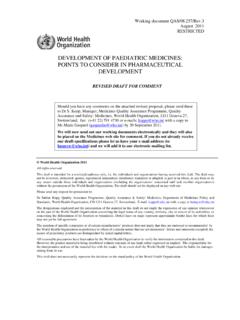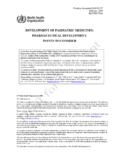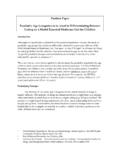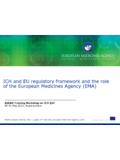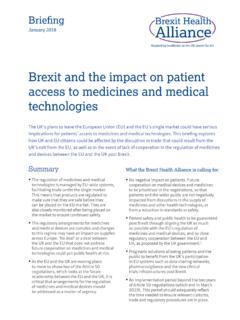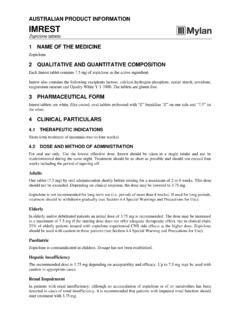Transcription of Paediatric emergency triage, assessment and treatment
1 UPDATED. GUIDELINE. Paediatric emergency triage , assessment and treatment Care of critically ill children UPDATED GUIDELINE. Paediatric emergency triage , assessment and treatment Care of critically ill children WHO Library Cataloguing-in-Publication Data Guideline: updates on Paediatric emergency triage , assessment and treatment : care of critically-ill children. treatment . Care. Health Organization. ISBN 978 92 4 151021 9 (NLM classification: WA 320). World Health Organization 2016. All rights reserved. Publications of the World Health Organization are available on the WHO website ( ) or can be purchased from WHO Press, World Health Organization, 20 Avenue Appia, 1211 Geneva 27, Switzerland (tel.: +41 22 791. 3264; fax: +41 22 791 4857; e-mail: Requests for permission to reproduce or translate WHO publications whether for sale or for non-commercial distribution should be addressed to WHO Press through the WHO website ( html).)
2 The designations employed and the presentation of the material in this publication do not imply the expression of any opinion whatsoever on the part of the World Health Organization concerning the legal status of any country, territory, city or area or of its authorities, or concerning the delimitation of its frontiers or boundaries. Dotted and dashed lines on maps represent approximate border lines for which there may not yet be full agreement. The mention of specific companies or of certain manufacturers' products does not imply that they are endorsed or recommended by the World Health Organization in preference to others of a similar nature that are not mentioned. Errors and omissions excepted, the names of proprietary products are distinguished by initial capital letters. All reasonable precautions have been taken by the World Health Organization to verify the information contained in this publication. However, the published material is being distributed without warranty of any kind, either expressed or implied.
3 The responsibility for the interpretation and use of the material lies with the reader. In no event shall the World Health Organization be liable for damages arising from its use. Suggested citation Updated guideline: Paediatric emergency triage , assessment and treatment . Geneva: World Health Organization; 2016. Contents Abbreviations and acronyms iv Definitions v Acknowledgements vii Executive summary 1. Scope and purpose of the guideline 5. 1. Background 6. 2. Methods 13. 3. Evidence and recommendations 18. Detection of hypoxaemia and use of oxygen therapy 18. When to start and stop oxygen therapy for severely ill children with ETAT. emergency signs 19. Oxygen flow rate and humidification in severely ill children with emergency signs 24. Fluid management for critically ill children 28. Children who are not in shock but have signs of circulatory impairment 34. Children who are in shock 38. Management of seizures 43. Choice of anticonvulsant medicines for children with acute seizures when intravenous access is not available 44.
4 Choice of anticonvulsant medicines for children with acute seizures when intravenous access is available 47. Choice of second-line anticonvulsant medicines for children with established status epilepticus resistant to first-line benzodiazepines 49. Pharmacological interventions for prophylaxis of recurrence of febrile seizures 53. Role of diagnostic tests in the management of seizures with altered consciousness, particularly by non-specialists in low- and middle-income countries 57. 4. Dissemination, adaptation and implementation 62. References 64. Annex 1. Declarations of interest 71. UPDATED GUIDELINE | Paediatric emergency triage , assessment AND treatment iii Abbreviations and acronyms AVPU Alert (A), responds to your Voice (V), responds to Pain (P), Unresponsive (U). bw body weight CI confidence interval CNS central nervous system CT computerized tomography EEG electroencephalography ETAT emergency triage , assessment and treatment FEAST fluid expansion as supportive therapy FiO2 fraction of inspired oxygen GDG Guideline Development Group GRADE Grading of Recommendations assessment , Development and Evaluation HFNC high-flow nasal cannula IM intramuscular IV intravenous MCA Maternal, Newborn, Child and Adolescent Health (WHO department of).
5 MRI magnetic resonance imaging PaO2 partial pressure of oxygen PICO population, intervention, control, outcome RCT randomized controlled trial RR relative risk SpO2 peripheral capillary oxygen saturation iv UPDATED GUIDELINE | Paediatric emergency triage , assessment AND treatment . Definitions Acute symptomatic seizure: seizures that occur in close temporal relation to a brain insult such as trauma, infection or metabolic or structural abnormalities Coma: unconscious state as defined on the AVPU scale: Alert (A), responds to your Voice (V), responds to Pain (P), Unresponsive (U). Convulsion: see Seizure . Critical illness: any severe problem with the airway, breathing or circulation, or acute deterioration of conscious state; includes apnoea, upper airway obstruction, hypoxaemia, central cyanosis, severe respiratory distress, total inability to feed, shock, severe dehydration, active bleeding requiring transfusion, unconsciousness or seizures Cyanosis: a bluish discoloration of skin and mucous membranes due to excessive concentration of reduced haemoglobin in the blood emergency signs (as described in this guideline): obstructed or absent breathing severe respiratory distress central cyanosis signs of shock (defined as cold extremities with capillary refill time > 3 s and weak, fast pulse).
6 Coma (or seriously reduced level of consciousness). seizures signs of severe dehydration in a child with diarrhoea with any two of the following signs: lethargy or unconsciousness, sunken eyes, very slow return of skin after pinching Febrile seizure: a seizure occurring in childhood after 1 month of age associated with fever not caused by an infection of the central nervous system (CNS), without previous neonatal seizures or a previous unprovoked seizure and not meeting the criteria for other acute symptomatic seizures (International League against Epilepsy, 1993). Hyperoxaemia: high blood oxygen tension or increased oxygen content of the blood Hypoxaemia: abnormally low level of oxygen in the blood [peripheral capillary oxygen saturation (SpO2) < 90%]; more specifically, oxygen deficiency in arterial blood Hypoxia: diminished availability of oxygen to body tissues Neonate: an infant aged 0 28 days Seizure: transient signs and/or symptoms due to abnormal excessive or synchronous neuronal activity in the brain with a clear start and finish (International League against Epilepsy, 2015).
7 Seizures can present as a wide array of physical changes or changes in consciousness, of varying severity. For the purposes of this guideline, the term seizure is used to refer only to convulsive seizures and is equivalent to the term convulsion . Severe anaemia: erythrocyte volume fraction (haematocrit) < 15 or haemoglobin < 5 g/dL. UPDATED GUIDELINE | Paediatric emergency triage , assessment AND treatment v Severe acute malnutrition: in infants and children aged 6 59 months, weight-for-height < 3 Z-score of the median of the WHO growth standards, or clinical signs of bilateral oedema of nutritional origin, even if other measures are above specified cut-off values (WHO, 2009a). Severe dehydration: two or more of the following signs present: lethargy or unconsciousness, sunken eyes, unable to drink or drinks poorly, skin returns very slowly after pinching ( 2 s). Severely impaired circulation: cold extremities or a weak and fast pulse or capillary refill > 3 s Shock: cold extremities with capillary refill > 3 s and a weak, fast pulse (all signs must be present).
8 SpO2: peripheral capillary oxygen saturation, usually measured with a transcutaneous monitor Status epilepticus: a condition of abnormally prolonged seizures. For generalized convulsions, the operational definition is 5 min of continuous seizures or two or more discrete seizures without complete recovery of consciousness in between, with 30 min of seizure activity resulting in long- term neurological sequelae (International League Against Epilepsy, 2015). vi UPDATED GUIDELINE | Paediatric emergency triage , assessment AND treatment . Acknowledgements The WHO departments of Maternal, Newborn, Child and Adolescent Health (MCA) and Mental Health and Substance Abuse gratefully acknowledge the contributions of many individuals and organizations to the development of this guideline. Guideline Development Group (GDG). Special thanks are due to Professor Trevor Duke and Professor Eddie Lang for serving as chairpersons of the Group. Chair Trevor Duke, Centre for International Child Health, University of Melbourne, Australia GRADE methodologist Eddy Lang, Department of emergency Medicine, University of Calgary, Alberta, Canada Members Andrew Argent, School of Child and Adolescent Health, University of Cape Town, Red Cross War Memorial Children's Hospital, Cape Town, South Africa.
9 Joe Brierley, Paediatric and Neonatal Intensive Care, Great Ormond Street Hospital, London, United Kingdom Harry Campbell, Public Health Sciences, University of Edinburgh Medical School, Scotland, United Kingdom Queen Dube, Department of Paediatrics, College of Medicine, Blantyre, Malawi Michael English, Department for Public Health Research, Kenya Medical Research Institute . Wellcome Trust Research Programme, Nairobi, Kenya Hans Hartmann, Department of Paediatric Kidney, Liver and Metabolic Diseases, Hanover Medical School, Germany Tabish Hazir, Department of Paediatrics, Children's Hospital, Pakistan Institute of Medical Sciences, Islamabad, Pakistan Angelina Kakooza-Mwesige, Department of Paediatrics and Child Health, Makerere University College of Health Sciences, School of Medicine, Kampala, Uganda Niranjan Kissoon, Department of Paediatrics and emergency Medicine, University of British Columbia, Vancouver, Canada Mehretie Kokeb, Department of Paediatrics and Child Health, College of Medicine and Health Sciences, University of Gondar, Ethiopia Christian Korff, Paediatric Neurology, Child and Adolescent Department, Children's Hospital, Geneva University Hospitals, Switzerland Linn Kyaw, Paediatric Neurology, Yangon Children's Hospital, Myanmar Juan Manuel Lozano Le n.
10 Medical and Health Sciences Research, Herbert Wertheim College of Medicine, Florida International University, Miami, Florida, USA. UPDATED GUIDELINE | Paediatric emergency triage , assessment AND treatment vii Leyla Namzova-Baranova, National Centre for Child Health of the Russian Academy of Medical Science, Moscow, Russian Federation Charles Newton, Kenya Medical Research Institute Wellcome Trust Research Programme, Nairobi, Kenya Archana Patel, Department of Paediatrics, Director of the Clinical Epidemiology Unit, Indira Gandhi Government Medical College, Nagpur, India Ida Safitri Laksono, Department of Paediatrics, Gadjah Mada University, Yogyakarta, Indonesia Sunit Singhi, Paediatric emergency and Intensive Care Services, Post-graduate Institute of Medical Education and Research, Chandigarh, India Manal Hassan Taha, Department of Primary Health Care, Federal Ministry of Health, Khartoum, Sudan Technical experts who participated in the scoping meeting in March 2013.










